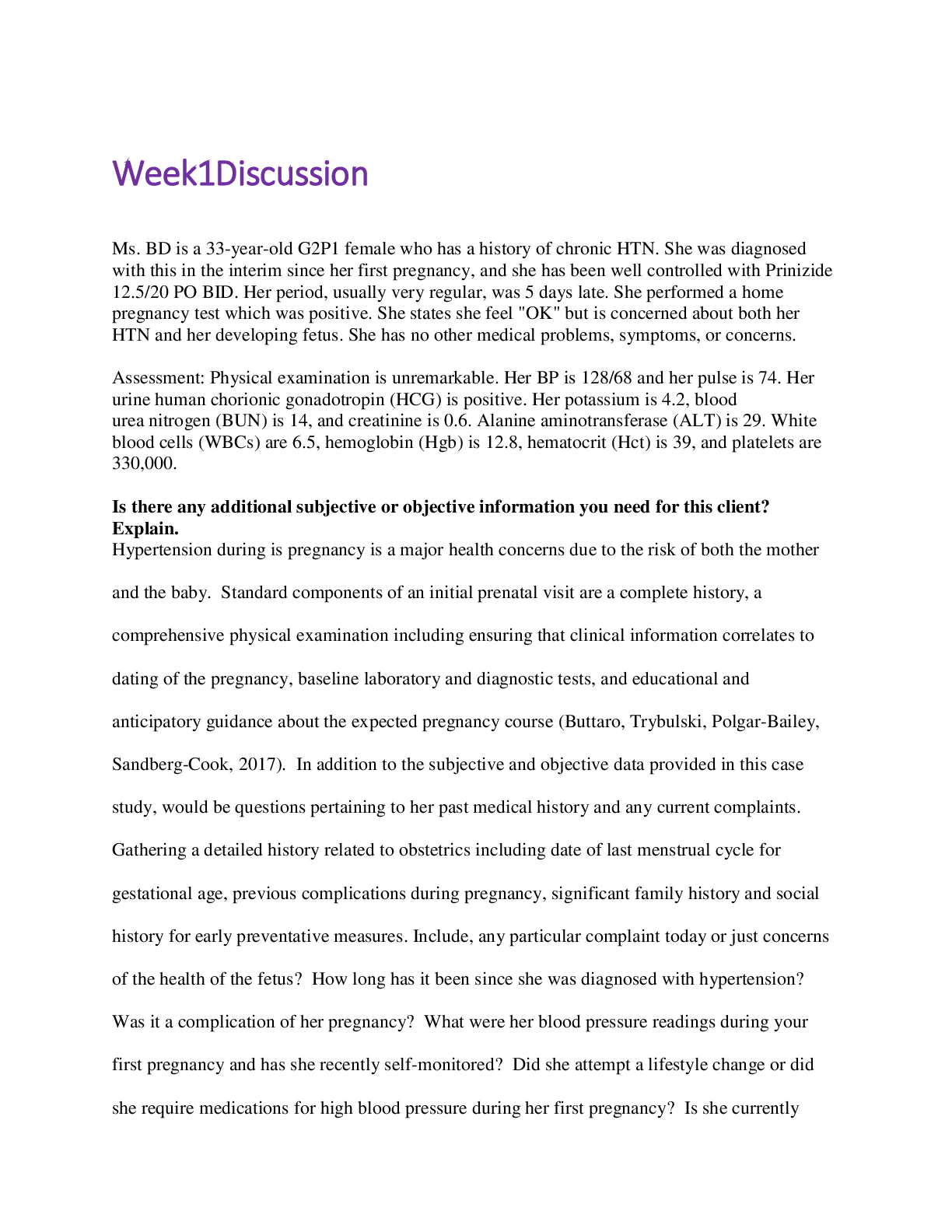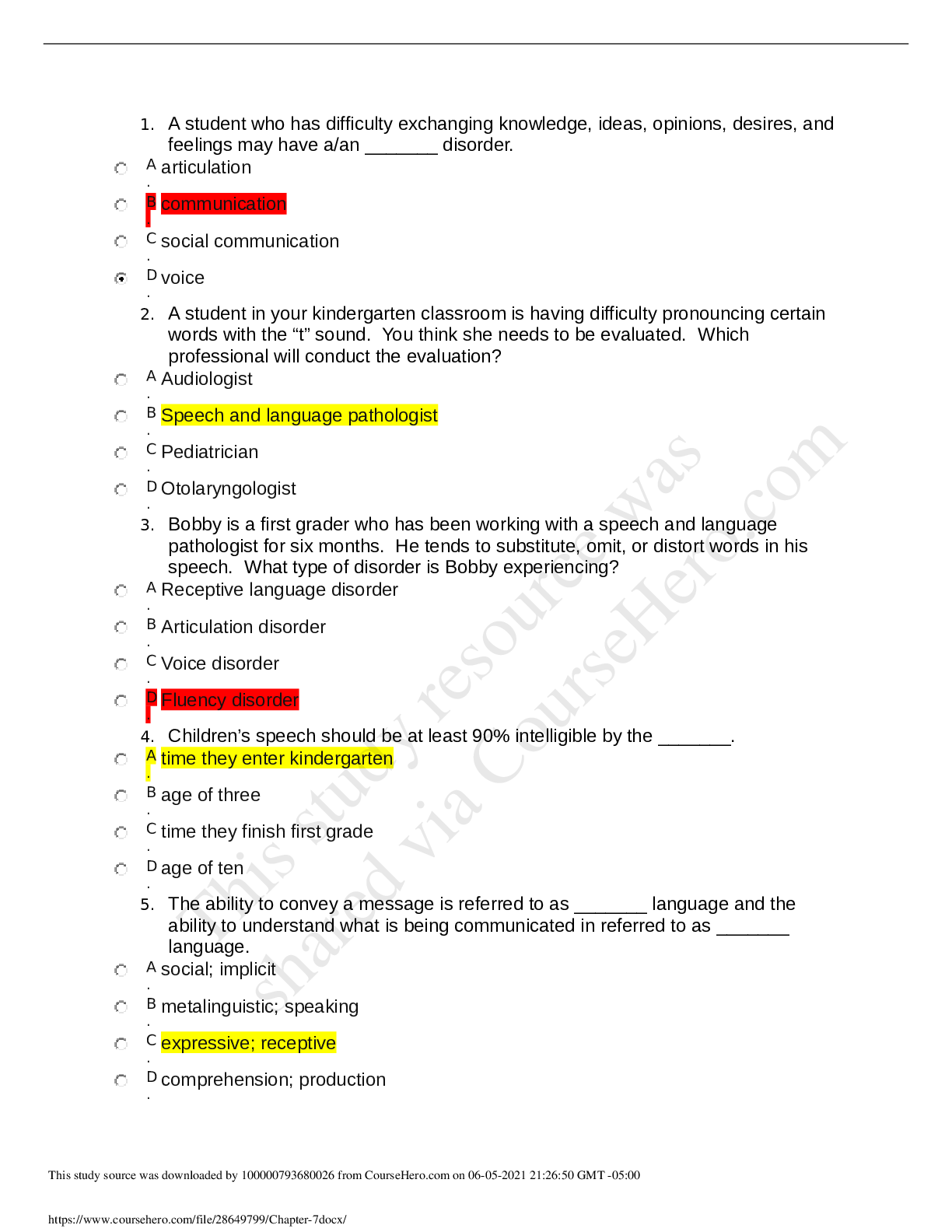*NURSING > DISCUSSION POST > NSG 6005 Test Bank Week1Discussion (All)
NSG 6005 Test Bank Week1Discussion
Document Content and Description Below
Week1Discussion Ms. BD is a 33-year-old G2P1 female who has a history of chronic HTN. She was diagnosed with this in the interim since her first pregnancy, and she has been well controlled with Prin... izide 12.5/20 PO BID. Her period, usually very regular, was 5 days late. She performed a home pregnancy test which was positive. She states she feel "OK" but is concerned about both her HTN and her developing fetus. She has no other medical problems, symptoms, or concerns. Assessment: Physical examination is unremarkable. Her BP is 128/68 and her pulse is 74. Her urine human chorionic gonadotropin (HCG) is positive. Her potassium is 4.2, blood urea nitrogen (BUN) is 14, and creatinine is 0.6. Alanine aminotransferase (ALT) is 29. White blood cells (WBCs) are 6.5, hemoglobin (Hgb) is 12.8, hematocrit (Hct) is 39, and platelets are 330,000. Is there any additional subjective or objective information you need for this client? Explain. Hypertension during is pregnancy is a major health concerns due to the risk of both the mother and the baby. Standard components of an initial prenatal visit are a complete history, a comprehensive physical examination including ensuring that clinical information correlates to dating of the pregnancy, baseline laboratory and diagnostic tests, and educational and anticipatory guidance about the expected pregnancy course (Buttaro, Trybulski, Polgar-Bailey, Sandberg-Cook, 2017). In addition to the subjective and objective data provided in this case study, would be questions pertaining to her past medical history and any current complaints. Gathering a detailed history related to obstetrics including date of last menstrual cycle for gestational age, previous complications during pregnancy, significant family history and social history for early preventative measures. Include, any particular complaint today or just concerns of the health of the fetus? How long has it been since she was diagnosed with hypertension? Was it a complication of her pregnancy? What were her blood pressure readings during your first pregnancy and has she recently self-monitored? Did she attempt a lifestyle change or did she require medications for high blood pressure during her first pregnancy? Is she currentlyhaving any signs or symptoms of high blood pressure, if so what are they and how long have they been occurring? Does anything make them worse, perhaps better or resolve? Do the signs and symptoms affect her daily living? Physical examination should include a baseline height, weight and body mass index to assess the progress throughout her pregnancy. Besides the interview process, obtaining a uric acid level is beneficial to detect the severity of the disease along with identifying any adverse maternal and perinatal outcomes (Kumar, Singh, & Maini, 2017). A urinary analysis for protein as a baseline. Is Prinzide safe in pregnancy? What are the possible complications to the pregnant woman and her fetus? Prinzide is a combination of lisinopril and hydrochlorothiazide used to treat hypertension. According to Micromedex (2018) if pregnancy is detected while a patient is taking lisinopril/hydrochlorothiazide, it is recommended that the drug be discontinued as soon as possible. Additionally, the mother should be apprised of the potential hazards to the fetus. In rare cases where alternative therapy may not be acceptable, inform the patient of the associated risk with continued lisinopril/hydrochlorothiazide therapy and monitor frequently for oligohydramnios with serial ultrasound examinations; fetal testing may also be conducted based on week of pregnancy. If oligohydramnios is detected, discontinue lisinopril/hydrochlorothiazide unless it is lifesaving for the mother. Irreversible injury to the fetus may already occur prior to the detection of oligohydramnios. Also, closely monitor infants with histories of in utero exposure to lisinopril/hydrochlorothiazide for hypotension, oliguria, and hyperkalemia. If oliguria or hypotension occurs, institute appropriate management such as blood pressure support, renal perfusion support, and possibly exchange transfusion or dialysis. (para. 16)Why is it important to assess the above laboratory values? How might this information impact your treatment plan? Laboratory testing during pregnancy is necessary to obtain a baseline for monitor progress. These tests can help find conditions that can increase the risk of complications for mother and fetus (American College of Obstetricians and Gynecologists, 2017). Would you make any changes to Ms. BD’s blood pressure medications? Explain. If yes, what would you prescribe? Discuss the medications safety in pregnancy, mechanism of action, route, the half-life; how it is metabolized in and eliminated from the body; and contraindications and black box warnings. Yes, stop prinzide immediately. “Methyldopa, labetalol, and nifedipine are the most commonly used oral agents to treat severe chronic hypertension in pregnancy” (Leeman, Dresang, & Fontaine, 2016, p. 122). However, at this time I would encourage her to make necessary lifestyle changes to prevent the use of antihypertensive medications until her blood pressure is consistently greater than 150/100. Medication safety during pregnancy is critical to protect mother first then baby. Pharmacokinetics refers to the absorption, distribution, metabolism and excretion of a drug. Determining the safety is recommended by utilizing the manufacturers package insert, the collaboration of specialists, standards of practice and current research for comprehensive information about specific drugs (Wirfs, 2017). A black box warning or boxed warning is the U.S. Food and Drug Administration’s most serious warning for drugs that may cause serious injury or death (Llamas, 2018). What health maintenance or preventive education is important for this client based on your choice medication/treatment?Safe management is the goal for better patient outcomes. To preserve the safety of the mother and baby all medications will be discontinued with exception to prenatal vitamin daily. Instruct and education mother on daily self-monitoring of blood pressures and report any blood pressure readings greater than 150/100 or signs and symptoms of high blood pressure. Educate the mother on a heart healthy diet, limiting sodium intake to prevent fluid retention increasing risk of high blood pressures. Would you treat this patient or refer her? Where would you refer this patient? Based on her assessment today, I would agree to schedule a follow up appointment in one week to review blood pressure readings and any specific complaints. However, as a family nurse practitioner (FNP) and her history of chronic hypertension, I will collaborate with a certified nurse midwife (CNM) colleague for input and recommendations until the mother can schedule her first prenatal visit with her primary CNM or obstetrician. References American College of Obstetricians and Gynecologists. (2017). Routine test during pregnancy. Retrieved August 25, 2018, from https://www.acog.org/Patients/FAQs/Routine-TestsDuring-Pregnancy#why Buttaro, T. M., Trybulski, J., Polgar-Bailey, P., Sandberg-Cook, J. (2017). Primary Care: A Collaborative Practice, 5th Edition. [South University]. Retrieved from https://digitalbookshelf.southuniversity.edu/#/books/9780323355018/ Kumar, N., Singh, A. K., & Maini, B. (2017). Impact of maternal serum uric acid on perinatal outcome in women with hypertensive disorders of pregnancy: A prospective study. Pregnancy Hypertension: An International Journal of Women's Cardiovascular Health, 10220-225. doi: 10.1016/j.preghy.2017.10.002Llamas, M. (2018). Black Box Warnings - Fast-Tracked Drugs & Increased Use. Retrieved from https://www.drugwatch.com/fda/black-box-warnings/ Micromedex. (2018). Lisinopril/hydrochlorothiazide. Retrieved August 25, 2018, from http://www.micromedexsolutions.com.southuniversity.libproxy.edmc.edu/micromedex2/l ibrarian/PFActionId/hcs.external.RetrieveDocument/ContentSetCode/DRUGDEXEVALS/DocId/2163/topicId/dosingInformationSection/subtopicId/adultDosageSection# Wirfs, M. J. (2017). The APRN’s Complete Guide to Prescribing Drug Therapy 2018. New York, NY: Springer Publishing Company Notes Angela, I enjoyed your discussion and the overview of safe medication management in pregnancy. As I prepared my discussion, I discovered the U.S. Food & Drug Administration (FDA) is no longer utilizing the pregnancy risk letter categories. According to the FDA (2015), as of June 2015 they will use information for the subsections of pregnancy exposure registry, clinical considerations, and data to provide information about dosing and potential risks to the developing fetus. They found many women require drug treatment during pregnancy due to chronic conditions such as hypertension in this particular case study and withhold drug treatment would be dangerous for both mother and baby. Lisinopril/hydrochlorothiazide was approved in 2002 therefore not requiring the new labeling of pregnancy risk. I also learned the prinzide brand name has been discontinued in the U.S. Are you familiar with the new guidelines to obtain approval of medication safety in pregnancy?References U.S. Food and Drug Administration. (2015). FDA approved drug products. Retrieved from https://www.accessdata.fda.gov/scripts/cder/daf/index.cfm?event=overview.process&Ap plNo=076007 [Show More]
Last updated: 2 years ago
Preview 1 out of 6 pages

Buy this document to get the full access instantly
Instant Download Access after purchase
Buy NowInstant download
We Accept:

Reviews( 0 )
$9.00
Can't find what you want? Try our AI powered Search
Document information
Connected school, study & course
About the document
Uploaded On
Jan 19, 2021
Number of pages
6
Written in
Additional information
This document has been written for:
Uploaded
Jan 19, 2021
Downloads
0
Views
132





